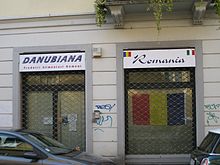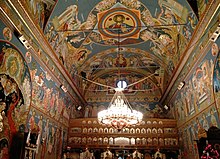Romanians in Italy
 | |
| Total population | |
|---|---|
| 1,072,001 Romanian citizens (2022)[1] | |
| Regions with significant populations | |
| Rome, Turin, Milan, Bologna, Padua, Verona, Florence, Guidonia Montecelio, Aprilia, Venice[2] | |
| Languages | |
| Italian, Romanian | |
| Religion | |
| Predominantly Orthodox Christianity; also Roman Catholicism[3] | |
| Related ethnic groups | |
| Romanian people, Romanian diaspora, Romanian Britons, Romanian Australians, Romanian Americans, Romanian Canadians, Romanian French people |
| Part of a series of articles on |
| Romanians |
|---|
 |
Romanians in Italy (Romanian: românii din Italia; Italian: romeni in Italia or rumeni in Italia) became a significant population after 1999, due to a large wave of emigration known in Romania as Fenomenul migrației către UE (the phenomenon of migration toward the European Union). A large part of Romanian emigrants went to Spain or Italy, whose national languages are Romance languages like Romanian. They were followed by another wave beginning in 2002, when Romanian citizens obtained the right to move to any Schengen Zone country without a visa. In 2007 Romania joined the European Union, further increasing the economic and political ties between the countries.
As of 2022[update], there were 1,072,001 Romanian citizens living in Italy, the largest Romanian immigrant population in any country as well as the largest immigrant group within Italy.[4]
Between 2008 and 2020, 98,499 Romanians acquired Italian citizenship.[5]

Demographics
Romanians in Italy live in the following regions of Italy (as of 2022):[6]
- Lazio 18,1%
- Lombardia 15,8%
- Piemonte 12,3%
- Veneto 11,7%
- Emilia-Romagna 8,8%
- Toscana 6,8%
- Sicilia 4,2%
- Campania 3,1%
- Puglia 2,7%
- Calabria 2,4%
- Friuli Venezia Giulia 2,4%
- Marche 2,2%
- Umbria 2,1%
- Abruzzo 2,0%
- Liguria 2,0%
- Trentino-Alto Adige 1,3%
- Sardegna 1,0%
- Basilicata 0,7%
- Molise 0,3%
- Valle d'Aosta 0,2%
Rome and Turin are by far the cities hosting the largest communities of Romanians in Italy; in 2016, there were over 90,000 Romanians in Rome, and over 50,000 Romanians in Turin.[2] The next city with a significant population of Romanians is Milan, with over 14,000 Romanians.[2]
About 60% of Romanians in Italy come from the Romanian region of Western Moldavia.[7]
Population
| Romanian citizens resident in Italy, 2001-2022 | |||
|---|---|---|---|
| 2001 (Census) | 74,885 | — | [8] |
| 2002 | 95,039 | 26.9% | [9] |
| 2003 | 177,812 | 87.1% | [10] |
| 2004 | 248,849 | 40.0% | [11] |
| 2005 | 297,570 | 19.6% | [12] |
| 2006 | 342,200 | 15.0% | [13] |
| 2007 | 625,278 | 82.7% | [14] |
| 2008 | 796,477 | 27.4% | [15] |
| 2009 | 887,763 | 11.5% | [16] |
| 2010 | 968,576 | 9.1% | [17] |
| 2011 (Census) | 823,100 | -17.7% | [18] |
| 2012 | 933,354 | 13.4% | [19] |
| 2013 | 1,081,400 | 15.9% | [20] |
| 2014 | 1,131,839 | 4.7% | [21] |
| 2015 | 1,151,395 | 1.7% | [22] |
| 2016 | 1,168,552 | 1.5% | |
| 2017 | 1,190,091 | 1.8% | |
| 2018 | 1,143,859 | -3,9% | |
| 2019 | 1,145,718 | 0.2% | |
| 2020 | 1,076,412 | [23] | |
| 2021 | 1,083,771 | [23] | |
| 2022 | 1,072,001 | [24] | |
Religion

In the years 2011 and 2012 the ISTAT made a survey regarding the religious affiliation among the immigrants in Italy, the religion of the Romanian people in Italy were as follows:[25]
- Orthodox Christians: 79.0%
- Catholics: 13.9%
- Protestants: 2.2%
- Muslims: 0.1%
- Non religious: 2.7%
- Other religions: 2.2%
Notable people
- This list includes people of Romanian origin born in Italy or people born in Romania but mainly active in Italy.
- Dinu Adameșteanu (1913–2004), archaeologist
- Alexandra Agiurgiuculese (b. 2001), rhythmic gymnast
- Chris Avram (1931–1989), actor
- Ramona Bădescu (b. 1968), actress and television host
- Paolo Bonolis (b. 1961), television host
- Cristian Chivu (b. 1980), football player
- Fritz Dennerlein (1936–1992), freestyle swimmer
- Iosif Drăgan (1917–2008), businessman and historian
- Nicolao Dumitru (b. 1991), football player
- Loredana Errore (b. 1984), singer-songwriter
- Mădălina Ghenea (b. 1987), actress and model
- Alessandro Haber (b. 1947), actor, film director and singer
- Claudia Koll (b. 1965), actress and missionary
- Veronica Lazăr (1938–2014), actress
- Marius Mitrea (b. 1982), rugby union referee
- Ana Caterina Morariu (b. 1980), actress
- Gabriele Oriali (b. 1952), football player
- Cristina Pîrv (b. 1972), volleyball player
- Bogdan Rath (b. 1972), water polo player
- Andreea Stefanescu (b. 1993), rhythmic gymnast
- Cristian Stoica (b. 1976), rugby union footballer
- Linda Valori (b. 1978), singer
- Roman Vlad (1919–2013), composer and pianist
- Virginia Zeani (b. 1925), soprano
See also
References
- ^ http://dati.istat.it/Index.aspx?DataSetCode=DCIS_POPSTRRES1
- ^ a b c http://www.comuni-italiani.it/statistiche/stranieri/ro.html
- ^ "Appartenenza e pratica religiosa tra i cittadini stranieri". 4 September 2019.
- ^ http://dati.istat.it/Index.aspx?DataSetCode=DCIS_POPSTRRES1
- ^ "Acquisizioni di cittadinanza". dati.istat.it (in Italian).
- ^ "Romeni in Italia - statistiche e distribuzione per regione". Tuttitalia.it (in Italian). Retrieved 2023-09-07.
- ^ Cohal (2014). Mutamenti nel romeno di immigrati in Italia (in Italian). FrancoAngeli. ISBN 978-88-917-0625-6.
- ^ ISTAT, ed. (2004-06-16). "14º Censimento della popolazione: dati definitivi. Stranieri residenti in famiglia e in convivenza" (PDF).
- ^ ISTAT (ed.). "Cittadini Stranieri. Popolazione residente per sesso e cittadinanza al 31 Dicembre 2002, Italia - Tutti i Paesi".
- ^ ISTAT (ed.). "Cittadini Stranieri. Popolazione residente per sesso e cittadinanza al 31 Dicembre 2003, Italia - Tutti i Paesi".
- ^ ISTAT (ed.). "Cittadini Stranieri. Popolazione residente per sesso e cittadinanza al 31 Dicembre 2004, Italia - Tutti i Paesi".
- ^ ISTAT (ed.). "Cittadini Stranieri. Popolazione residente per sesso e cittadinanza al 31 Dicembre 2005, Italia - Tutti i Paesi".
- ^ ISTAT (ed.). "Cittadini Stranieri. Popolazione residente per sesso e cittadinanza al 31 Dicembre 2006, Italia - Tutti i Paesi".
- ^ ISTAT (ed.). "Cittadini Stranieri. Popolazione residente per sesso e cittadinanza al 31 Dicembre 2007, Italia - Tutti i Paesi".
- ^ ISTAT (ed.). "Cittadini Stranieri. Popolazione residente per sesso e cittadinanza al 31 Dicembre 2008, Italia - Tutti i Paesi".
- ^ ISTAT (ed.). "Cittadini Stranieri. Popolazione residente per sesso e cittadinanza al 31 Dicembre 2009, Italia - Tutti i Paesi".
- ^ ISTAT (ed.). "Cittadini Stranieri. Popolazione residente per sesso e cittadinanza al 31 Dicembre 2010, Italia - Tutti i Paesi".
- ^ ISTAT (ed.). "Gli stranieri al 15º Censimento della popolazione" (PDF).
- ^ ISTAT (ed.). "Cittadini Stranieri. Popolazione residente per sesso e cittadinanza al 31 Dicembre 2012, Italia - Tutti i Paesi".
- ^ ISTAT (ed.). "Cittadini Stranieri. Popolazione residente per sesso e cittadinanza al 31 Dicembre 2013, Italia - Tutti i Paesi".
- ^ ISTAT (ed.). "Cittadini Stranieri. Popolazione residente per sesso e cittadinanza al 31 Dicembre 2014, Italia - Tutti i Paesi".
- ^ "Bilancio demografico nazionale, 2015". ISTAT.
- ^ a b "Popolazione residente e dinamica demografica" (PDF). istat.it (in Italian). 15 December 2022. Retrieved 12 April 2023.
- ^ http://dati.istat.it/Index.aspx?DataSetCode=DCIS_POPSTRRES1
- ^ "Appartenenza e pratica religiosa tra i cittadini stranieri". www.istat.it (in Italian). 2014-10-30. Retrieved 2020-03-01.
External links
- La comunità romena in Italia website

